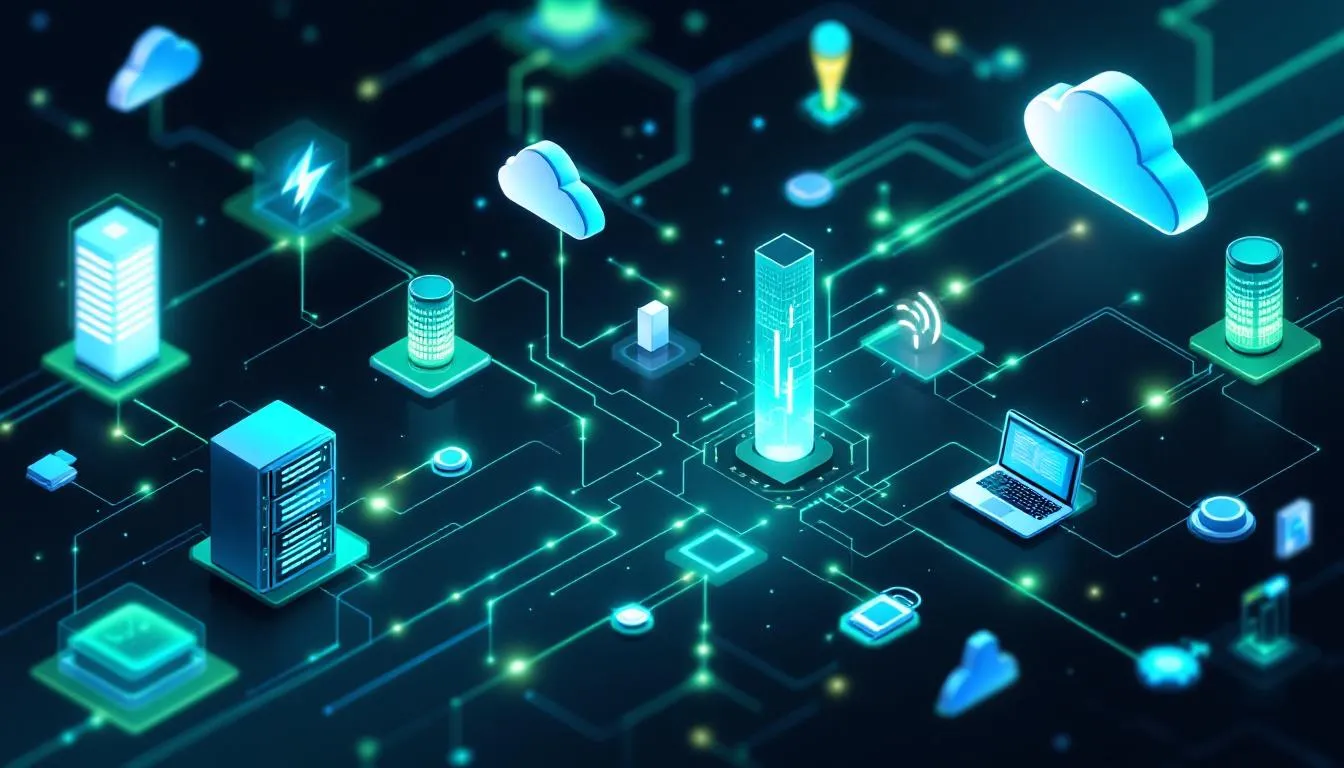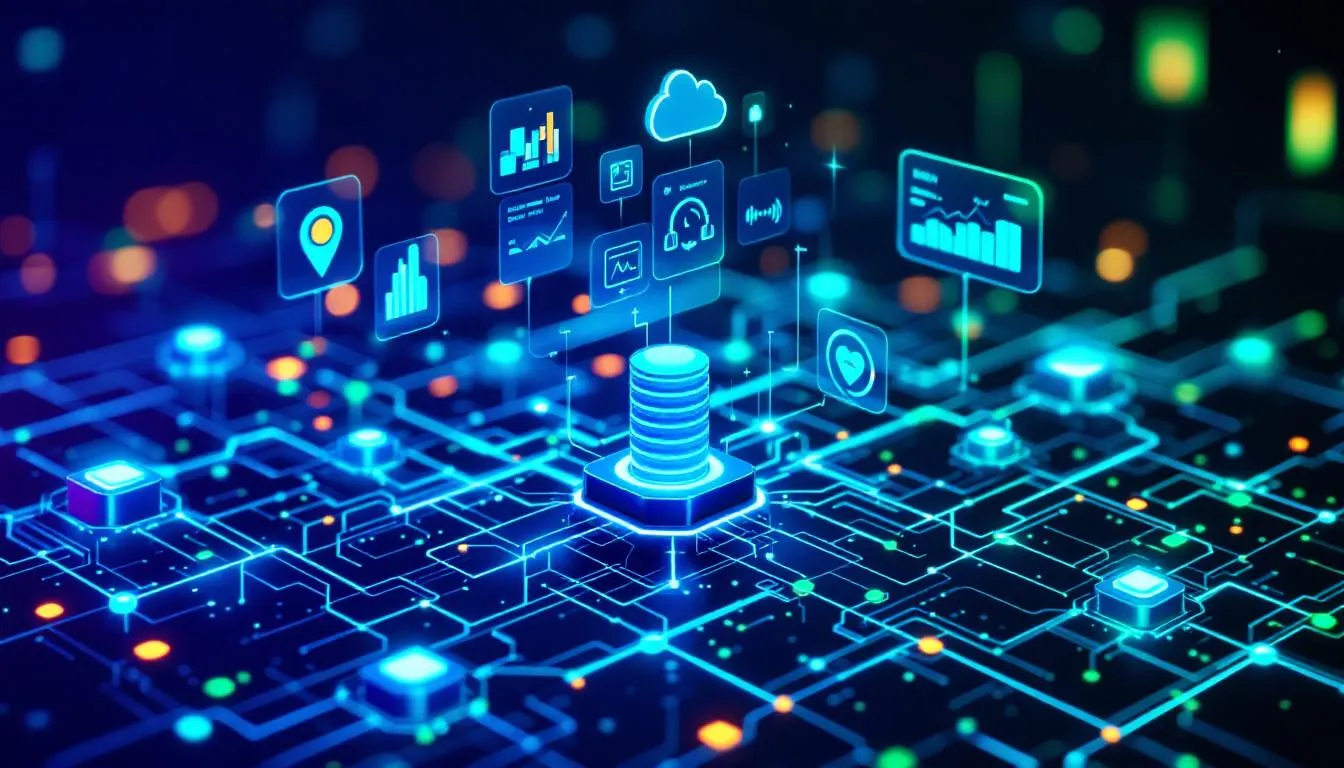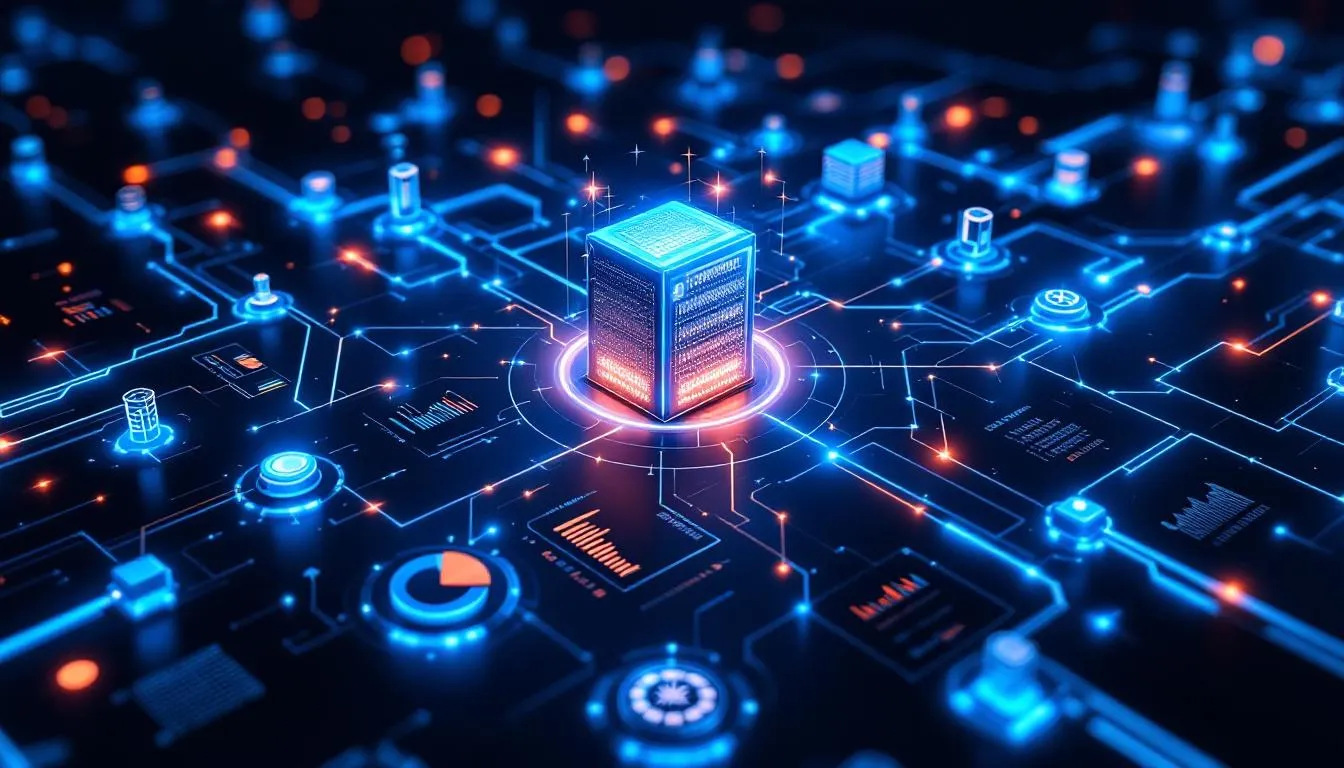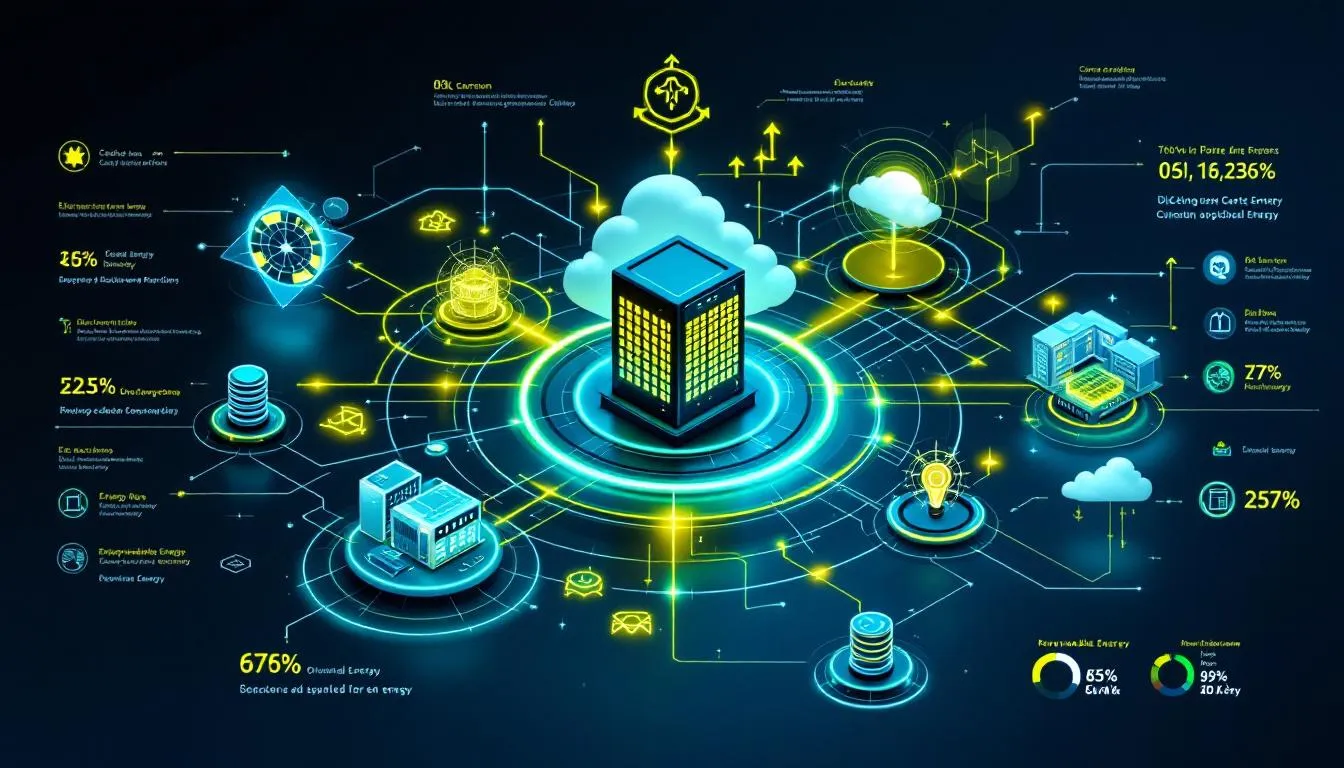
Looking to optimize your data center‘s efficiency and performance? Key data center metrics are essential. This article will guide you through the most important metrics for monitoring energy use, carbon emissions, IT performance, and more. By understanding these metrics, you can reduce costs and improve sustainability.
Key Takeaways
- Key metrics for data center efficiency include Power Usage Effectiveness (PUE), Cooling Efficiency Ratio (CER), and Energy Reuse Effectiveness (ERE), which collectively assess energy consumption and reuse.
- Carbon emissions tracking is essential, with metrics like Carbon Usage Effectiveness (CUE) and Carbon Intensity helping data centers to align with sustainability standards and reduce their carbon footprint.
- Operational and performance metrics, including IT equipment performance, storage usage, and resource utilization, are critical for enhancing data center efficiency and optimizing overall performance.
Essential Metrics for Data Center Efficiency
Understanding essential metrics is crucial for data center efficiency. Power Usage Effectiveness (PUE) is a key metric, comparing total energy consumption in a data center to the energy consumed by IT equipment. PUE is calculated by dividing the total energy used by the facility by the energy used by IT equipment.
The Cooling Efficiency Ratio (CER) measures the efficiency of cooling systems by comparing the heat removed to the energy consumed by cooling operations. As cooling systems represent a significant portion of total energy consumption, CER is crucial for assessing their effectiveness.
Energy Reuse Effectiveness (ERE) quantifies how well a data center reuses energy. Calculated by multiplying PUE with the Energy Reuse Factor (ERF), which is the amount of reused energy divided by the total energy consumed, these metrics provide a comprehensive view of energy efficiency and resource utilization.
Energy Consumption Metrics
Energy consumption metrics reveal how much power a data center uses and its operational efficiency. Total energy consumption includes energy used by both supporting equipment and IT hardware. Accurate tracking requires treating data centers as systems defined by specific energy use interfaces.
The Renewable Energy Factor (REF) shows the percentage of renewable energy used compared to total energy consumption in a data center, aiding sustainability efforts. Similarly, the On-site Energy Fraction (OEF) indicates the share of energy derived from on-site renewable sources relative to the total power needed.
Energy Reuse Effectiveness (ERE) also assesses how efficiently a data center reuses energy for external purposes. Monitoring these metrics provides valuable insights into energy consumption patterns and opportunities for improvement.
Carbon Emissions Tracking
Tracking carbon emissions is crucial for data centers focused on sustainability. Carbon Usage Effectiveness (CUE) assesses carbon emissions relative to the energy consumed by IT equipment and aligns with standards like ISO/IEC 30134-8 and EN 50600-4-8.
Calculate the carbon intensity of total energy consumption by calculating the total energy consumption by (1 – OEF), adjusting for energy reuse, and then multiplying by the CO2-equivalent of the local grid. This approach helps data centers accurately track and manage carbon emissions, contributing to global sustainability efforts.
IT Equipment Performance Metrics
Optimizing IT equipment performance is key for data center efficiency. New equipment Energy Utilization for servers (ITEUsv) measures actual server utilization and energy management during operations, indicating optimal energy efficiency at higher utilization levels.
The ITUE metric measures energy consumption of IT equipment, calculated as total IT power divided by compute power. Server energy productivity compares total energy consumed by a server to the amount of compute work it accomplishes, calculated by dividing the percentage of energy consumption by the percentage of compute work done.
Performance insights from tools like the Performance Diagnostics tool support system tuning and capacity planning by exposing potential resource utilization issues. Monitoring key performance indicators kpis helps optimize performance, including:
- CPU utilization
- Memory utilization
- Network utilization
- Disk utilization
Operational Metrics for Data Center Management
Operational metrics assess the maturity of data center processes. Measuring operational data helps operators make informed decisions to improve efficiency and performance. Tracking maintenance activities and service level agreements (SLAs) ensures consistent performance and reliability.
Accurate documentation improves operational processes within data centers. Regular security training for staff is essential for maintaining data center integrity and safety. Focusing on these metrics enhances operational efficiency and ensures smooth operations to collect data.
Storage and Disk Usage Metrics
Storage and disk usage metrics assess data center performance and data center kpis. Key metrics include:
- Input/Output Operations Per Second (IOPS) measures storage system performance.
- IOPS quantifies read and write operations per second.
- It is crucial for understanding workload efficiency.
Latency in disk usage metrics indicates the average number of time taken to complete read/write operations, typically in milliseconds. Lower latency means quicker response times, vital for applications needing fast data access.
Throughput indicates the amount of data transferred over a period, often measured in bytes per second. Total disk space used reflects the overall total capacity consumed by data and applications. Monitoring these metrics helps allocate resources efficiently and ensure optimal storage performance, including how much capacity is available, the total number of resources, and the total amount of data processed.
Network Performance Metrics
Network performance metrics assess the reliability and efficiency of data transmission. Packet loss occurs when data packets fail to reach their destination, indicating potential issues. Throughput measures the rate at which data successfully travels across a network within a given timeframe.
Latency is the time it takes for a data packet to travel to its destination and back, significantly affecting performance. Jitter refers to variability in packet arrival times, disrupting real-time applications like video conferencing. Bandwidth indicates the maximum data transfer capacity, impacting overall speed and performance.
Network availability quantifies the percentage of time a network is operational and accessible, critical for reliability. Packet duplication and reordering affect performance by causing duplicate data or incorrect sequences. Monitoring these metrics helps improve uptime and maintain a reliable and efficient network.
Virtual Machine Metrics
Virtual machine performance is monitored using the following metrics like other metrics:
- IOPS: Indicates the number of read and write operations a storage system can handle per second, a critical measure for database and virtual machine performance.
- Throughput: Measures the total data volume transferred over a period, typically in bytes per second.
- Latency: (mentioned but not defined in the text).
Latency is the delay time required to complete a single I/O operation, with lower latency resulting in quicker response times for applications. The relationship among IOPS, throughput, and latency is crucial: IOPS specifies the number of operations, throughput indicates the data amount per operation, and latency shows the time taken for each.
Block size influences both IOPS and throughput, affecting performance measurements.
Cost and Resource Utilization Metrics
Cost and resource utilization metrics reveal the financial efficiency of data centers and computer systems. The relationship between digital power cost and hardware energy efficiency is crucial for operators. Effective data analysis can help determine insights into operational processes and highlights areas for cost reductions.
Data Center Cost per Workload (DCCW) assesses financial efficiency by comparing total operational costs to hosted workloads, helping operators identify cost-saving opportunities and improve performance.
Cost efficiency in data centers reduces operating expenses and ensures cost effective sustainable growth in a data center facility.
Sustainability and Renewable Energy Metrics
Sustainability and renewable energy metrics are vital as data centers may account for 8% of global energy consumption by 2030. The ideal On-site Energy Fraction (OEF) for renewable energy coverage is 1, indicating complete reliance on on-site sources. The Renewable Energy Factor (REF) represents the percentage of renewable energy over total data center energy.
On-site renewable energy sources power generation lowers a data center’s carbon footprint based on the percentage of energy from renewable sources. Focusing on these metrics helps operators enhance sustainability efforts and contribute to global environmental goals, including the use of electricity.
Summary
In conclusion, understanding and implementing these key metrics is crucial for optimizing data center performance and efficiency. From energy consumption and carbon emissions tracking to IT equipment performance and cost efficiency, these metrics provide a comprehensive framework for improving data center operations. As the data center industry continues to grow, focusing on these metrics will ensure sustainable and efficient growth.
Frequently Asked Questions
What is Power Usage Effectiveness (PUE)?
Power Usage Effectiveness (PUE) measures a data center’s total energy consumption against the energy consumed by its IT equipment, thus illustrating its energy efficiency. A lower PUE value signifies a more efficient data center.
How can data centers track their carbon emissions?
Data centers can effectively track their carbon emissions by utilizing the Carbon Usage Effectiveness (CUE) metric, which evaluates emissions in relation to the energy consumed by IT equipment. This method provides a clear insight into their environmental impact.
What is the significance of the Renewable Energy Factor (REF)?
The Renewable Energy Factor (REF) is significant as it quantifies the proportion of renewable energy utilized in a data center, enabling operators to monitor and enhance their sustainability initiatives effectively.
How do IT Equipment Energy Utilization (ITEUsv) and ITUE metrics differ?
ITEUsv focuses on server utilization and energy management during operation, whereas ITUE quantifies energy consumption by comparing total IT power to compute power. Thus, ITEUsv is more about operational efficiency, while ITUE is a broader measure of energy use.
Why are operational metrics important for data center management?
Operational metrics are essential for evaluating data center processes, monitoring maintenance tasks, ensuring compliance with service level agreements (SLAs), and upholding the integrity and safety of the facility. By leveraging these metrics, data center management can significantly enhance operational efficiency.





